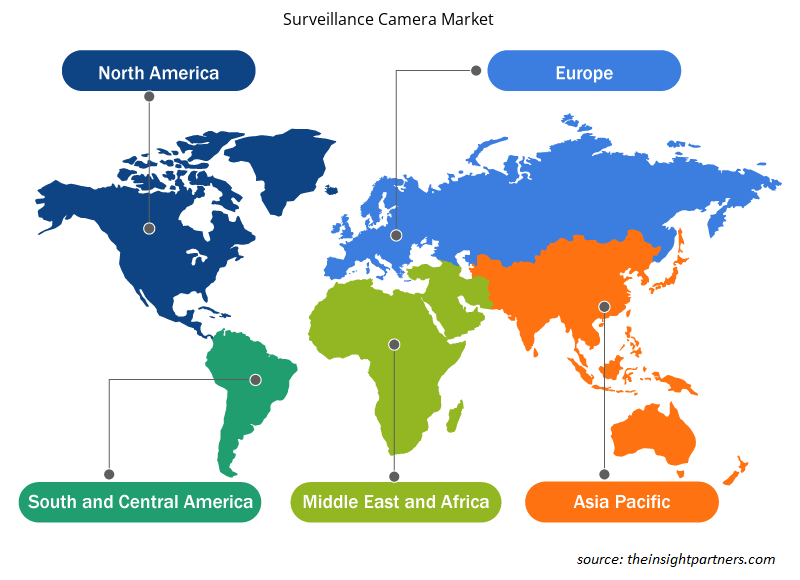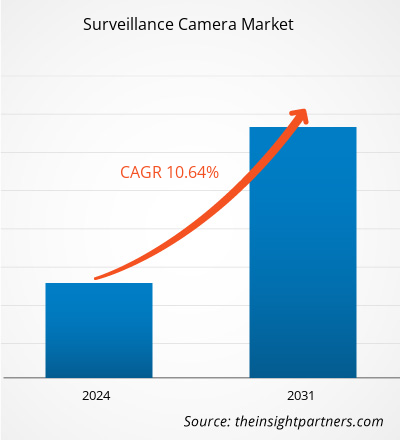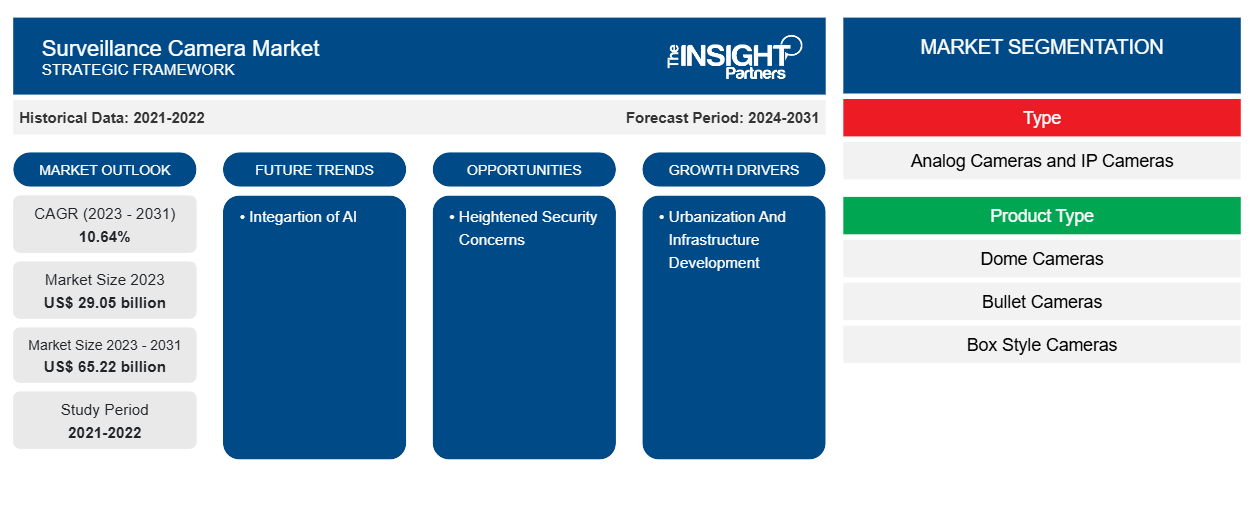من المتوقع أن يصل حجم سوق كاميرات المراقبة إلى 65.22 مليار دولار أمريكي بحلول عام 2031 من 29.05 مليار دولار أمريكي في عام 2023. ومن المتوقع أن يسجل السوق معدل نمو سنوي مركب بنسبة 10.64٪ في الفترة 2023-2031. إن المخاوف الأمنية المتزايدة هي التي تدفع سوق كاميرات المراقبة العالمية.CAGR of 10.64% in 2023–2031. The growing security concern drives the global surveillance camera market.
تحليل سوق كاميرات المراقبة
تتكون شبكة كاملة من كاميرات المراقبة من نظام دائرة مغلقة يستخدم لمراقبة والتحكم في عقار معين. غالبًا ما تعمل هذه الكاميرات على شبكات IP (بروتوكول الإنترنت)، والتي تربط كاميرات المراقبة من الموقع البعيد بالموقع الرئيسي. تنقل كاميرات المراقبة أو الأمان الفيديو المسجل إلى مسجل فيديو الشبكة (NVR) في شكل إشارات رقمية من خلال كابل PoE واحد، مما يزيل الحاجة إلى كابلات الطاقة.NVR (Network Video Recorder) in the form of digital signals through a single PoE cable, removing the requirement for power cables.
نظرة عامة على سوق كاميرات المراقبة
كاميرات المراقبة هي كاميرات تراقب المنطقة التي تم تركيبها فيها. تعمل هذه الكاميرات جنبًا إلى جنب مع أنظمة الأمان. يمكن تركيب هذه الكاميرات في المكاتب أو المنازل أو متاجر التجزئة أو أي مكان عام لضمان الأمن وردع العمل الإجرامي أيضًا. تُستخدم اللقطات المسجلة لهذه الكاميرات أيضًا كدليل في حالة وقوع الجريمة. يمكن للمرء أن يجد أنواعًا مختلفة من كاميرات المراقبة ذات أنواع مختلفة من الميزات. تُستخدم كاميرا المراقبة بشكل أفضل لمراقبة منطقة معينة وبالتالي التحكم في أي موقف غير مرغوب فيه. تم تصميم كاميرات المراقبة لتنبيه السلطات عند حدوث نشاط إجرامي. يتم دمجها مع الذكاء الاصطناعي، لكن كاميرات الأمان هي مجرد كاميرات تسجل لقطات.
قم بتخصيص هذا التقرير ليناسب متطلباتك
ستحصل على تخصيص لأي تقرير - مجانًا - بما في ذلك أجزاء من هذا التقرير، أو تحليل على مستوى الدولة، وحزمة بيانات Excel، بالإضافة إلى الاستفادة من العروض والخصومات الرائعة للشركات الناشئة والجامعات
-
احصل على أهم اتجاهات السوق الرئيسية لهذا التقرير.ستتضمن هذه العينة المجانية تحليلاً للبيانات، بدءًا من اتجاهات السوق وحتى التقديرات والتوقعات.
محركات وفرص سوق كاميرات المراقبة
التوسع الحضري وتطوير البنية التحتية لصالح السوق
تلعب تقنيات المراقبة دورًا حاسمًا في تحسين البنية التحتية والخدمات الحضرية. توفر أجهزة الاستشعار والكاميرات البيانات للمساعدة في إدارة حركة المرور وتحسين استهلاك الطاقة وإدارة النفايات وتطوير أنظمة نقل أفضل. تسهل هذه الرؤى التخطيط الحضري المستنير، مما يؤدي إلى مدن موفرة للموارد ومستدامة. علاوة على ذلك، توفر أنظمة كاميرات المراقبة المتكاملة في المدن الذكية قدرات لا مثيل لها في ضمان سلامة وأمن السكان. تسهل المراقبة في الوقت الفعلي الاستجابة السريعة لحالات الطوارئ والكشف في الوقت المناسب عن الشذوذ وإدارة الحشود بشكل فعال أثناء الأحداث أو الأزمات. وبالتالي، فإن التوسع الحضري وتطوير البنية التحتية يدفعان نمو سوق كاميرات المراقبة.
مخاوف أمنية متزايدة
تكتسب الكاميرات وأنظمة مراقبة الفيديو ومنصات التشغيل البيني المزيد من الاهتمام أكثر من أي وقت مضى بسبب المخاوف المتعلقة بالسلامة العامة. لم يكن التسرع في تثبيت المزيد من الكاميرات وتحسين أنظمة مراقبة الفيديو أكثر من أي وقت مضى. تنشر دول مختلفة كاميرات مراقبة لأغراض أمنية. على سبيل المثال، في فبراير 2024، مع اقتراب الغزو الروسي الكامل لأوكرانيا من علامة العامين، يخشى خبراء الأمن الرقمي الأوكرانيون والمسؤولون الحكوميون أن تؤدي مئات الآلاف من كاميرات المراقبة الصينية الصنع من طراز Hikvision وDahua التي تستخدمها أنظمة الأمن التي تديرها الحكومة والمساكن والشركات الخاصة في جميع أنحاء أوكرانيا إلى زيادة مخاطر الهجمات من قبل الجيش الروسي. وبالتالي، فإن زيادة المخاوف الأمنية المتزايدة تخلق فرصًا لنمو سوق كاميرات المراقبة.
تقرير تحليل تجزئة سوق كاميرات المراقبة
إن القطاعات الرئيسية التي ساهمت في اشتقاق تحليل سوق كاميرات المراقبة هي النوع ونوع المنتج والمستخدم النهائي.
- اعتمادًا على النوع، يتم تقسيم سوق كاميرات المراقبة إلى كاميرات تناظرية وكاميرات IP.
- وفقًا لنوع المنتج، يتم تقسيم سوق كاميرات المراقبة إلى كاميرات قبة، وكاميرات رصاصية، وكاميرات على شكل صندوق، وكاميرات PTZ، وكاميرات حرارية، وغيرها.
- بناءً على المستخدم النهائي، يتم تقسيم سوق كاميرات المراقبة إلى BFSI، والحكومة والدفاع، والتجارية، والتصنيع والبناء، والرعاية الصحية، والخدمات اللوجستية والنقل، والسكنية، وغيرها.
تحليل حصة سوق كاميرات المراقبة حسب المنطقة الجغرافية
ينقسم النطاق الجغرافي لتقرير سوق كاميرات المراقبة بشكل أساسي إلى خمس مناطق: أمريكا الشمالية، ومنطقة آسيا والمحيط الهادئ، وأوروبا، والشرق الأوسط وأفريقيا، وأمريكا الجنوبية/أمريكا الجنوبية والوسطى. يوجد في أمريكا الشمالية العديد من مقدمي كاميرات المراقبة؛ اللاعبون هم CCTV Security Pro وآخرون. علاوة على ذلك، تخضع الولايات المتحدة لمراقبة شديدة. يوجد في أتلانتا وحدها 50 كاميرا مراقبة لكل 1000 نسمة. وبالتالي، فإن مثل هذه الحالات تدفع نمو سوق كاميرات المراقبة.
رؤى إقليمية حول سوق كاميرات المراقبة
لقد قام المحللون في Insight Partners بشرح الاتجاهات والعوامل الإقليمية المؤثرة على سوق كاميرات المراقبة طوال فترة التوقعات بشكل شامل. يناقش هذا القسم أيضًا قطاعات سوق كاميرات المراقبة والجغرافيا في جميع أنحاء أمريكا الشمالية وأوروبا ومنطقة آسيا والمحيط الهادئ والشرق الأوسط وأفريقيا وأمريكا الجنوبية والوسطى.

- احصل على البيانات الإقليمية المحددة لسوق كاميرات المراقبة
نطاق تقرير سوق كاميرات المراقبة
| سمة التقرير | تفاصيل |
|---|---|
| حجم السوق في عام 2023 | 29.05 مليار دولار أمريكي |
| حجم السوق بحلول عام 2031 | 65.22 مليار دولار أمريكي |
| معدل النمو السنوي المركب العالمي (2023 - 2031) | 10.64% |
| البيانات التاريخية | 2021-2022 |
| فترة التنبؤ | 2024-2031 |
| القطاعات المغطاة |
حسب النوع
|
| المناطق والدول المغطاة |
أمريكا الشمالية
|
| قادة السوق وملفات تعريف الشركات الرئيسية |
|
كثافة اللاعبين في السوق: فهم تأثيرها على ديناميكيات الأعمال
يشهد سوق كاميرات المراقبة نموًا سريعًا، مدفوعًا بالطلب المتزايد من جانب المستخدم النهائي بسبب عوامل مثل تفضيلات المستهلكين المتطورة والتقدم التكنولوجي والوعي المتزايد بفوائد المنتج. ومع ارتفاع الطلب، تعمل الشركات على توسيع عروضها والابتكار لتلبية احتياجات المستهلكين والاستفادة من الاتجاهات الناشئة، مما يؤدي إلى زيادة نمو السوق.
تشير كثافة اللاعبين في السوق إلى توزيع الشركات أو المؤسسات العاملة في سوق أو صناعة معينة. وهي تشير إلى عدد المنافسين (اللاعبين في السوق) الموجودين في مساحة سوق معينة نسبة إلى حجمها أو قيمتها السوقية الإجمالية.
الشركات الرئيسية العاملة في سوق كاميرات المراقبة هي:
- شركة كانون
- شركة داهوا للتكنولوجيا المحدودة
- شركة فلير سيستمز
- شركة هانغتشو هيكفيجن للتكنولوجيا الرقمية المحدودة
- شركة هانوا تيكوين المحدودة
- شركة هونيويل الدولية
إخلاء المسؤولية : الشركات المذكورة أعلاه ليست مرتبة بأي ترتيب معين.

- احصل على نظرة عامة على أهم اللاعبين الرئيسيين في سوق كاميرات المراقبة
أخبار سوق كاميرات المراقبة والتطورات الأخيرة
يتم تقييم سوق كاميرات المراقبة من خلال جمع البيانات النوعية والكمية بعد البحث الأولي والثانوي، والتي تتضمن منشورات الشركات المهمة وبيانات الجمعيات وقواعد البيانات. فيما يلي قائمة بالتطورات في السوق:
- في يناير 2024، قدمت شركة Consistent Infosystems، وهي شركة متخصصة في منتجات تكنولوجيا المعلومات والإلكترونيات وصناعات الترفيه المنزلي، مجموعة جديدة من كاميرات المراقبة المصنوعة في الهند في الهند، مما عزز محفظة منتجات الأمن والمراقبة القوية بالفعل. تقدم المجموعة الجديدة من كاميرات المراقبة حل مراقبة كامل. وهي تتضمن كاميرا PT لاسلكية ذكية 4G، وكاميرا تعمل بالطاقة الشمسية 4G، وكاميرا لاسلكية Pan-Tilt Wifi 3MP/4MP Mini wifi P2P Plug and Play Hassle Free، وكاميرا ملونة 4G وكاميرا CCTV 4G Dome.
(المصدر: Consistent Infosystems، موقع الشركة الإلكتروني، 2021)
- في فبراير 2023، أطلقت شركة Idis مجموعة من كاميرات الذكاء الاصطناعي المتطورة. تم تصميم الكاميرات الجديدة بناءً على تركيز الشركة على توسيع الاستخدام القابل للتطوير لمحرك التعلم العميق Idis الذي طورته بنفسها لتلبية احتياجات السلامة والأمان والتشغيل من خلال الخوادم والأجهزة والبرامج التي تعمل بالذكاء الاصطناعي لتناسب المؤسسات من جميع الأحجام في مجموعة واسعة من الأسواق الرأسية.
(المصدر: موقع شركة Idis، 2023)
تقرير سوق كاميرات المراقبة - التغطية والنتائج المتوقعة
يوفر تقرير "حجم سوق كاميرات المراقبة والتوقعات (2021-2031)" تحليلاً مفصلاً للسوق يغطي المجالات التالية:
- حجم السوق والتوقعات على المستويات العالمية والإقليمية والوطنية لجميع قطاعات السوق الرئيسية التي يغطيها النطاق
- ديناميكيات السوق مثل المحركات والقيود والفرص الرئيسية
- الاتجاهات المستقبلية الرئيسية
- تحليل مفصل لقوى PEST/Porter الخمس وSWOT
- تحليل السوق العالمي والإقليمي الذي يغطي اتجاهات السوق الرئيسية واللاعبين الرئيسيين واللوائح والتطورات الأخيرة في السوق
- تحليل المشهد الصناعي والمنافسة الذي يغطي تركيز السوق، وتحليل خريطة الحرارة، واللاعبين البارزين، والتطورات الأخيرة
- ملفات تعريف الشركة التفصيلية
- التحليل التاريخي (سنتان)، سنة الأساس، التوقعات (7 سنوات) مع معدل النمو السنوي المركب
- تحليل PEST و SWOT
- حجم السوق والقيمة / الحجم - عالمي، إقليمي، بلد
- الصناعة والمنافسة
- مجموعة بيانات إكسل
التقارير الحديثة
تقارير ذات صلة
شهادات العملاء
سبب الشراء
- اتخاذ قرارات مدروسة
- فهم ديناميكيات السوق
- تحليل المنافسة
- رؤى العملاء
- توقعات السوق
- تخفيف المخاطر
- التخطيط الاستراتيجي
- مبررات الاستثمار
- تحديد الأسواق الناشئة
- تحسين استراتيجيات التسويق
- تعزيز الكفاءة التشغيلية
- مواكبة التوجهات التنظيمية























 احصل على عينة مجانية ل - سوق كاميرات المراقبة
احصل على عينة مجانية ل - سوق كاميرات المراقبة